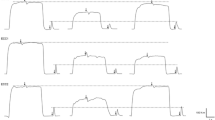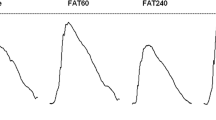Abstract
The effect of hamstring fatigue on knee extension torque was examined at different knee angles for seven male subjects. Before and after a dynamic flexion fatigue protocol (180° s−1, until dynamic torque had declined by 50%), maximal voluntary contraction extension torque was measured at four knee flexion angles (90°, 70°, 50° and 30°). Maximal torque generating capacity and voluntary activation of the quadriceps muscle were determined using electrical stimulation. Average rectified EMG of the biceps femoris was determined. Mean dynamic flexion torque declined by 48±11%. Extensor maximal voluntary contraction torque, maximal torque generating capacity, voluntary activation and average rectified EMG at the four knee angles were unaffected by the hamstring fatigue protocol. Only at 50° knee angle was voluntary activation significantly lower (15.7%) after fatigue (P<0.05). In addition, average rectified EMG before fatigue was not significantly influenced by knee angle. It was concluded that a fatigued hamstring muscle did not increase the maximal voluntary contraction extension torque and knee angle did not change coactivation. Three possible mechanisms may explain the results: a potential difference in recruited fibre populations in antagonist activity compared with the fibres which were fatigued in the protocol, a smaller loss in isometric torque generating capacity of the hamstring muscle than was expected from the dynamic measurements and/or a reduction in voluntary activation.






Similar content being viewed by others
References
Aagaard P, Simonsen EB, Andersen JL, Magnusson SP, Bojsen-Moller F, Dyhre-Poulsen P (2000) Antagonist muscle coactivation during isokinetic knee extension. Scand J Med Sci Sports 10:58–67
Aagaard P, Simonsen EB, Andersen JL, Magnusson SP, Dyhre-Poulsen P (2001) Changes in antagonist muscle coactivation pattern during maximal knee extension following heavy resistance strength training. J Physiol (Lond) 531:63P
Baratta R, Solomonow M, Zhou BH, Letson D, Chuinard R, D'Ambrosia R (1988) Muscular coactivation. The role of the antagonist musculature in maintaining knee stability. Am J Sports Med 16:113–122
Beelen A, Sargeant AJ (1991) Effect of fatigue on maximal power output at different contraction velocities in humans. J Appl Physiol 71:2332–2337
Beynnon B, Howe JG, Pope MH, Johnson RJ, Fleming BC (1992) The measurement of anterior cruciate ligament strain in vivo. Int Orthop 16:1-12
Bigland-Ritchie B, Rice CL, Garland SJ, Walsh ML (1995) Task-dependent factors in fatigue of human voluntary contractions. Adv Exp Med Biol 384:361–380
Casey A, Constantin-Teodosiu D, Howell S, Hultman E, Greenhaff PL (1996) Metabolic response of type I and II muscle fibers during repeated bouts of maximal exercise in humans. Am J Physiol 271:E38–E43
Draganich LF, Jaeger RJ, Kralj AR (1989) Coactivation of the hamstrings and quadriceps during extension of the knee. J Bone Joint Surg Am 71A:1075–1081
Draganich LF, Vahey JW (1990) An in vitro study of anterior cruciate ligament strain induced by quadriceps and hamstrings forces. J Orthop Res 8:57–63
Eloranta V (1989) Coordination of the thigh muscles in static leg extension. Electromyogr Clin Neurophysiol 29:227–233
Grabiner MD, Campbell KR, Hawthorne DL, Hawkins DA (1989) Electromyographic study of the anterior cruciate ligament-hamstrings synergy during isometric knee extension. J Orthop Res 7:152–155
Grabiner MD, Koh TJ, Miller GF (1992) Further evidence against a direct automatic neuromotor link between the ACL and hamstrings. Med Sci Sports Exerc 24:1075–1079
Haan A de, Ruiter CJ de, Woude LH van der, Jongen PJ (2000) Contractile properties and fatigue of quadriceps muscles in multiple sclerosis. Muscle Nerve 23:1534–1541
Hagood S, Solomonow M, Baratta R, Zhou BH, D'Ambrosia R (1990) The effect of joint velocity on the contribution of the antagonist musculature to knee stiffness and laxity. Am J Sports Med 18:182–187
Hirokawa S, Solomonow M, Lu Y, Lou ZP, D'Ambrosia R (1992) Anterior-posterior and rotational displacement of the tibia elicited by quadriceps contraction. Am J Sports Med 20:299–306
James C, Sacco P, Jones DA (1995) Loss of power during fatigue of human leg muscles. J Physiol (Lond) 484:237–246
Jones DA (1993) How far can experiments in the laboratory explain the fatigue of athletes in the field? In: Sargeant AJ, Kernell D (eds) Neuromuscular fatigue. North-Holland, Amsterdam, pp 100–108
Karatzaferi C, de Haan A, Ferguson RA, Mechelen W van, Sargeant AJ (2001) Phosphocreatine and ATP content in human single muscle fibres before and after maximum dynamic exercise. Pflugers Arch 442:467–474
Karatzaferi C, Haan A de, Mechelen W van, Sargeant AJ (2001) Metabolic changes in single human fibres during brief maximal exercise. Exp Physiol 86:411–415
Kaufman KR, An KN, Litchy WJ, Morrey BF, Chao EY (1991) Dynamic joint forces during knee isokinetic exercise. Am J Sports Med 19:305–316
Kellis E (1998) Quantification of quadriceps and hamstring antagonist activity [published erratum appears in Sports Med (1998) 25(3):211]. Sports Med 25:37–62
Kellis E, Baltzopoulos V (1996) Agonist and antagonist moment and EMG angle relationship during isokinetic eccentric and concentric exercise. Isokinet Exerc Sci 6:79–87
Kellis E, Baltzopoulos V (1996) The effects of normalization method on antagonistic activity patterns during eccentric and concentric isokinetic knee extension and flexion. J Electromyogr Kinesiol 6:235–245
Kellis E, Baltzopoulos V (1998) Muscle activation differences between eccentric and concentric isokinetic exercise. Med Sci Sports Exerc 30:1616–1623
Kellis E, Kellis S (2001) Effects of agonist and antagonist muscle fatigue on muscle coactivation around the knee in pubertal boys. J Electromyogr Kinesiol 11:307–318
Merletti R, Farina D, Hermens H, Freriks B, Harlaar J (1999) European recommendations for signal processing methods for surface electromyography. In: Hermens HJ, Freriks B, Merletti R, et al (eds) European recommendations for surface electromyography results of the SENIAM project. Roessingh Research and Development, Enschede, pp 57–68
Miller JP, Croce RV, Hutchins R (2000) Reciprocal coactivation patterns of the medial and lateral quadriceps and hamstrings during slow, medium and high speed isokinetic movements. J Electromyogr Kinesiol 10:233–239
More RC, Karras BT, Neiman R, Fritschy D, Woo SL, Daniel DM (1993) Hamstrings—an anterior cruciate ligament protagonist. An in vitro study. Am J Sports Med 21:231–237
Nisell R, Ericson MO, Nemeth G, Ekholm J (1989) Tibiofemoral joint forces during isokinetic knee extension. Am J Sports Med 17:49–54
Osternig LR, Hamill J, Corcos DM, Lander J (1984) Electromyographic patterns accompanying isokinetic exercise under varying speed and sequencing conditions. Am J Phys Med 63:289–297
Osternig LR, Caster BL, James CR (1995) Contralateral hamstring (biceps femoris) coactivation patterns and anterior cruciate ligament dysfunction. Med Sci Sports Exerc 27:805–808
Renstrom P, Arms SW, Stanwyck TS, Johnson RJ, Pope MH (1986) Strain within the anterior cruciate ligament during hamstring and quadriceps activity. Am J Sports Med 14:83–87
Solomonow M, Baratta R, Zhou BH, et al (1987) The synergistic action of the anterior cruciate ligament and thigh muscles in maintaining joint stability. Am J Sports Med 15:207–213
Yasuda K, Sasaki T (1987) Muscle exercise after anterior cruciate ligament reconstruction. Biomechanics of the simultaneous isometric contraction method of the quadriceps and the hamstrings. Clin Orthop 266–274
Acknowledgements
The authors would like to thank P.W. Verdijk for his technical assistance. In addition, the useful suggestions of Prof. dr. J.H. van Dieën and Prof. dr. T.M.G.J. van Eijden are very much appreciated.
Author information
Authors and Affiliations
Corresponding author
Rights and permissions
About this article
Cite this article
Beltman, J.G.M., Sargeant, A.J., Ball, D. et al. Effect of antagonist muscle fatigue on knee extension torque. Pflugers Arch - Eur J Physiol 446, 735–741 (2003). https://doi.org/10.1007/s00424-003-1115-y
Received:
Revised:
Accepted:
Published:
Issue Date:
DOI: https://doi.org/10.1007/s00424-003-1115-y




